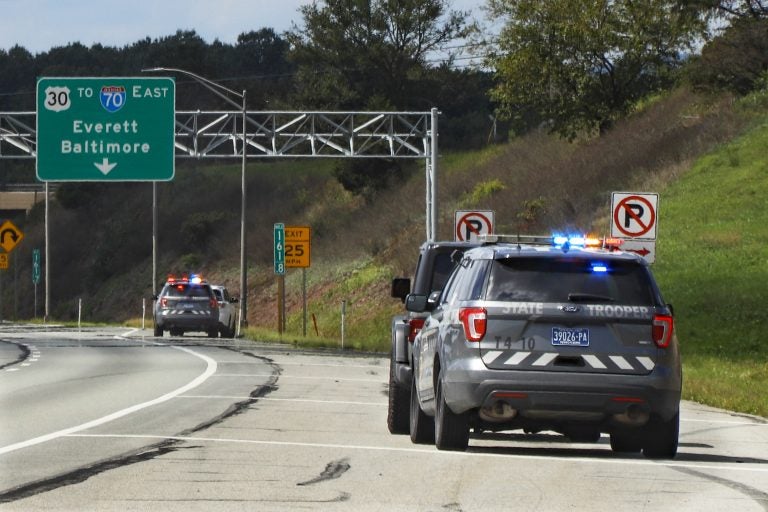‘Move over’ as you approach flashing lights on Pa. roads or face fines
The rules of the road in Pennsylvania are changing to protect first responders. Starting Tuesday, drivers need to “move over” or slow down when they see flashing lights.

File photo: Pennsylvania State troopers pull over drivers on Friday, Sept. 4, 2020, along the Pennsylvania Turnpike in Breezewood, Pa. (AP Photo/Keith Srakocic)
This story originally appeared on NBC10.
The rules of the road in Pennsylvania are changing to protect first responders. Starting Tuesday, drivers need to “move over” or slow down when they see flashing lights or face fines.
The new “Move Over Law” calls for drivers to move into the left lane when approaching an emergency vehicle with lights flashing — including police officers, EMS crews and tow truck drivers — or a disabled vehicle with proper indicators set up. If the driver can’t safely move into the outer lane on a highway or multilane road, then the driver needs to slow to 20 mph under the speed limit.
“Many drivers seem to think that moving over is just an optional courtesy when they see law enforcement or emergency vehicles pulled over on the side of the road,” Pennsylvania State Police Trooper Jessica Tobin said. “Emergency personnel can only do so much to keep themselves safe when they pull over on the side of the road. The rest of the responsibility falls on other motorists.”
Drivers who don’t give space or slow down face fines of $500 for a first offense up to $2,000 for a third or subsequent offense. A driver will have his or her license suspended for 90 days upon a third offense. A driver faces a fine up to $10,000 for a crash that hurts or injures a person.
AAA Mid-Atlantic notes that every state has some sort of law aimed at protecting roadside crews and emergency responders. Every two weeks a roadside worker is killed, AAA said.
Gov. Tom Wolf signed Act 105, which made changes to the previous “Steer Clear Law,” last October.
Here is a full breakdown of the new law, care of AAA Mid-Atlantic:
- Change the name of the current “Steer Clear Law” to the “Move Over Law”
- Provide that in an emergency response area along a road where there is an emergency response vehicle/operator (i.e. an EMS, police officer, tow truck driver, etc.), the motorist must move over into the left lane. If it is impossible for the motorist to move into the left lane, then the motorist is permitted to stay in the right lane, or in a lane adjacent to the emergency response area, but must reduce speed by 20 miles per hour below the posted speed limit.
- Allow a disabled vehicle, defined as, “a vehicle that is in a traffic lane or on the side of a traffic lane and the motorists is clearly marked with at least two of three markings (hazard lights, caution signs, or road flares),” to have the same protections as stated above in an emergency response situation, provided that the motorist with a disabled vehicle use two of the three following items: hazard lights, caution signs, or road flares.
- Imposes two points for failure to merge into the lane not next to the emergency response area.
- Set fines at $500 for first-time offenders, $1,000 for a second offense, and $2,000 for a third or subsequent offense.
- Require a 90-day license suspension for a third or subsequent offense. The license suspension will also apply to accidents that seriously harm or kill another person.• Set additional fines of up to $10,000 for violators who injure or kill an emergency service responder or an individual in or near a disabled vehicle.
- Double fines for several traffic violations when committed in an emergency response area when first responders are present.
“Emergency responders and roadside workers put themselves at risk every day to help people who are in need of emergency assistance or whose vehicles are broken down,” Jana L. Tidwell, manager of Public and Government Affairs for AAA Mid-Atlantic, said.
“As an organization committed to traffic safety, AAA asks that everyone join us in obeying the law to keep all highway heroes and those they’re responding to safe by slowing down and moving over anytime you see emergency vehicles stopped at the side of the road.”
WHYY is your source for fact-based, in-depth journalism and information. As a nonprofit organization, we rely on financial support from readers like you. Please give today.




